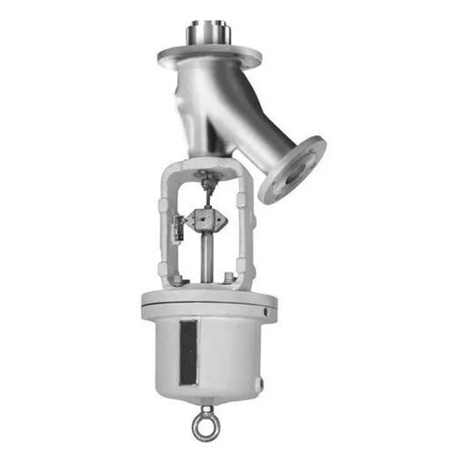Magpie Valve Selection: Accurate Matching Ensures Reliable Control
Valve Technology Sharing
Valve Selection and Advantages in Retrofit of Aging Reactors: Structural Benefits and Application of Rising-Stem Bottom Discharge Valves
Breaking the Bottleneck in Discharge: The Structural Edge and Scene Fit of Rising-Stem Bottom Discharge Valves in Aging Reactor Retrofit Projects
In the retrofit of aging reactors in industries such as chemicals, pharmaceuticals, and dyes, the selection of bottom discharge valves is critical to ensuring safe and efficient material discharge. This is especially true for challenging media like crystallizing, agglomerating, or sediment-prone substances (e.g., polymer slurries, salt crystallization solutions, molten resins). Traditional valve designs frequently suffer from clogging and deposition issues. In contrast, the rising-stem bottom discharge valve, designed with an upward-moving plug that "breaks through" blockages, has emerged as a powerful solution in such retrofits. This article explores its structural principles and real-world engineering advantages.

Unlike traditional descending-stem valves (in which the plug moves downward to open and close), the rising-stem valve features:
Stem Movement Direction: During opening, the valve plug retracts upward along the stem axis into the reactor, fully clearing the flow path. To close, it moves downward to seal against the valve seat.
Flange Compatibility: In a representative retrofit case, the original reactor had a DN65 outlet rated for PN16.0MPa (160kg class). After process adjustments, the system now operates at PN1.6MPa (16kg class). However, flange dimensions, such as bolt hole spacing and sealing face, were retained per the original rating to ensure seamless integration with the existing reactor interface and to avoid installation leakage caused by mismatched dimensions.
In processes where temperature drop or solvent evaporation leads to crystallization or sedimentation (e.g., stearic acid crystals, ammonium sulfate precipitation), descending-stem valves face significant challenges:
Obstruction: The downward-moving plug must penetrate any formed layers, leading to jamming or torque spikes (often 3–5 times higher than normal), risking deformation of the plug.
Seal Failure: Crystalline buildup on the valve seat interferes with sealing, leading to internal leakage (measured leakage rates can reach 5%–10%).
The rising-stem design overcomes these issues with its upward retraction mechanism:
Active Obstacle Clearance: Upon opening, the plug rises and uses its spherical or conical tip to push aside deposits (Figure 3), effectively penetrating layers up to 30mm thick. Because it avoids pushing against downward pressure, the required force is reduced by 40% compared to descending-stem designs.
Straight-Through Flow: A direct flow path boosts discharge velocity by 20%–30%, improving solids-carrying capacity and reducing residue. In one reactor case, discharge time dropped by 15%, and residual material was reduced by 60%.
Legacy reactors often undergo pressure de-rating (e.g., from 10MPa to 1.6MPa) while retaining original flanged outlets. The rising-stem valve addresses this with:
Dimensional Compatibility: While the valve body is selected for the new pressure class (e.g., 1.6MPa using WCB carbon steel), flange dimensions and bolt specs strictly follow the original high-pressure standards (e.g., 10MPa), avoiding costly modifications to reactor outlets (a ~70% cost saving compared to flange replacement).
No Compromise on Sealing: Despite lower operating pressures, the valve still features metal-to-metal seating (e.g., Stellite 6 hardfacing), with seating contact pressure ≥2.0MPa—1.1× the system's rated pressure—ensuring leak-tightness even with aged reactor interfaces. At one dye plant, leak alarms dropped from four per month to zero after the retrofit.
|
Feature |
Rising-Stem Bottom Discharge Valve |
Descending-Stem Bottom Discharge Valve |
|
Plug Movement Direction |
Retracts upward into the vessel |
Lowers out of the vessel |
|
Crystallization Performance |
Actively dislodges deposits, low jamming risk |
Must cut through deposits, high risk of plug blockage |
|
Retrofit Compatibility |
Matches original flange specs, no vessel modification |
May require flange rework due to mismatches |
|
Sealing Reliability |
Plug seals against a clean seat |
Seal may be compromised by embedded crystals |
|
Common Failure Mode |
Plug wear over time (easily replaceable) |
Plug deformation from blockage (requires full replacement) |
Rising-Stem Valve Recommended When:
The medium is prone to crystallization, sedimentation, or agglomeration (e.g., crystallizers, batch reactors).
Reactor flange interfaces must be preserved (e.g., high-pressure vessels now operating at lower pressures).
Fast discharge or minimal residue is critical (e.g., for flammable/explosive materials).
Descending-Stem Valve Suitable For:
Clean liquid media (e.g., water, solvents) with no risk of clogging.
Reactors with extremely limited bottom clearance where upward stem movement isn't feasible.
Engineering Case Study: Crystallizer Retrofit Boosts Efficiency
In one project involving an oxalic acid crystallizer:
Before Retrofit: A descending-stem valve frequently jammed due to crystallization (shutdowns every 3 batches for cleaning); crystal embedding in the seat caused internal leakage, with mother liquor losses averaging 5kg/batch.
After Retrofit: Replaced with a rising-stem valve (flanged to PN16.0 specs, designed for PN1.6), which easily dislodged the crystallized layer on opening. Discharge time dropped from 15 minutes to 8, with zero clogging. Post-shutdown inspection confirmed clean seats and no leakage. Annual savings from reduced mother liquor loss: approximately ¥200,000.
The rising-stem bottom discharge valve offers a structural innovation that directly addresses two common retrofit challenges: efficient discharge of complex media and seamless integration with legacy reactor interfaces. Its upward motion is not just a design detail. It is a rethinking of how valves can tackle the unique difficulties of crystallizing and sedimenting fluids.
In industrial modernization, the goal isn't to replace old equipment entirely, but to adapt precisely and upgrade intelligently. The rising-stem valve exemplifies this approach: by simply changing the plug's movement direction, it transforms the reactor's discharge point from a clog-prone bottleneck into a high-efficiency outlet.
If you're facing similar retrofit challenges or complex discharge requirements, reconsider the valve's movement logic and interface design. Sometimes, a small structural adjustment can yield significant performance improvements.
Let's explore more technical details in bottom discharge valve selection and legacy equipment upgrades, bridging old and new to unlock both efficiency and safety.
